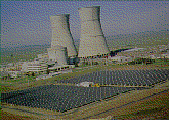Sacramento Municipal Utility District
Gary Sprung, Senior Real-Time Specialist
Operations Management Systems Dept.
Sacramento Municipal Utility District (Sacramento, California)
Sacramento Municipal Utility District (SMUD) operates two 1-megawatt photo voltaic generating plants, PV1 and PV2, the largest of their kind in the United States. Operating in a 20-acre field near the closed Rancho Seco Nuclear Generating Plant, PV1 and PV2 produce enough energy in the summer to power over 700 homes. In 1984, PV1 was the world’s first commercial photo voltaic power plant built and operated by a utility. In 1994, PV1 and PV2 needed new computer control systems. The original I/O systems and computers were long since out of production, and spares were no longer available. The CP/M-based multitasking BASIC program was difficult to maintain on the aging floppy-disk based computers. The original programmers of the turnkey system were long gone.

Photo shows SMUD’s 10-acre PV1 Photovoltaic Power Plant, with the closed Rancho Seco nuclear plant in the background. Photo courtesy of Sacramento Municipal Utility District (California).
A longer article about this application, including screens and code, appeared in I&CS Magazine, February, 1995. E-mail us for a reprint!
The decade since the inception of the PV project has seen tremendous advances in computer hardware, processor power, operating environments (as distinct from operating systems), and user expectations. High-resolution true-color display systems, driven by multi-MIPS processors executing object-based software, provide graphical user interfaces that define the new minimum expectations of users.
Any replacement control system must satisfy these expectations as well as the original real-time control system requirements, which are, by comparison, modest. The I/O systems require about 64 isolated analog inputs (current loop, millivolt and volt levels), 32 digital inputs (5 VDC to 120 VAC) and 32 digital outputs (5 VDC to 120 VAC). The control systems periodically operate drive motors that rotate the PV panel arrays east-west on their north-south-oriented axes. The center-grounded DC systems are monitored for ground faults and supply DC power to the inverters at voltages to 1,000
VDC and currents to 1,700 Amps. The inverters load the array fields to operate at the maximum power point of the PV cell IV (current/voltage) curve and convert the DC power to AC. Permission to operate is given by the Power System Operators 35 miles away, via remote terminal units that send data and receive control signals from the Energy Management System computers. Data collection is a significant portion of the PV control systems’ work, supplying long-term performance data as well as real-time data for graphical displays used in troubleshooting (clouds can cause fault currents).
A replacement control system must also deal effectively with maintenance and support issues in this lean-and-mean era of down-sizing, right-sizing and other staff "adjustments." Public utilities are only tax-exempt, not "ax-exempt." Our solution to this decision matrix is a replacement system consisting of distributed I/O networks from Digitronics, 486-based passive-backplane ISA computers from Industrial Computer Source and EXPRESS control system software from FORTH, Inc.
EXPRESS is an industrial control event-driven process engine that allows process engineers to decompose a control problem into a hierarchy of processes that evaluate English-language-like (no ladders!) rules in response to external or internal events. Coupled with an OSF/Motif-like graphical user interface, EXPRESS provides user-configurable live trending, historical trending, alarm/exception reporting, rule-tracking, I/O system exerciser, class-based real-time data base, graphical process displays, simultaneous multiple vendor I/O system scanning, I/O and process simulation for development, and multiple remote terminal access with full graphics. EXPRESS is supplied with complete source code, which has been of special comfort to us in adding an occasional custom feature. Regenerating the entire package takes under 40 seconds on a 486DX33.
More elaborate customization has been contracted to FORTH, Inc., who have been very responsive. A request to write custom drivers for the Digitronics Sixnet™ I/O system, when the PV development staff was reduced by 50% by the untimely death of the other staff member, brought us completed drivers in a week (EXPRESS already supports Modicon, Allen-Bradley, OPTO-22 OPTOMUX and PAMUX, plus others).
My management appreciates the availability of EXPRESS training classes (on site or at FORTH, Inc.) as well as FORTH, Inc.’s availability to do any or all parts of the applications, as needed. Maintainers and process engineers, as well as programmers, benefit from learning how to use the many tools EXPRESS provides. Programmers can support more systems if process engineers are allowed to define/refine the process rules and graphical displays of the base-line systems and if the maintainers learn to use the built-in tools to monitor system performance.
Replacement system software development has been rapid and uneventful, aided greatly by the simulation facilities of EXPRESS. The I/O Exerciser facility has been crucial in the archeological process of re-engineering the semi-documented I/O system. Remote access will greatly increase the visibility of PV operations and responsiveness to problems. With installation of the PV2 control system replacement in April 1994, the future of solar power and EXPRESS at SMUD looks bright.
